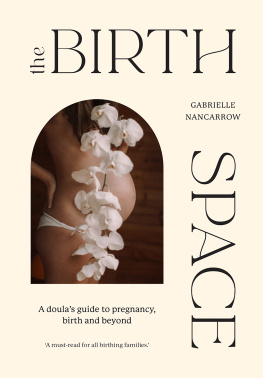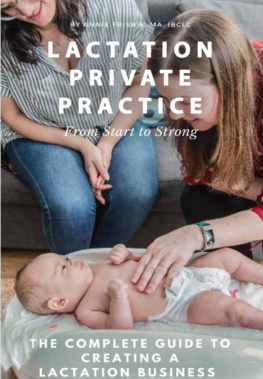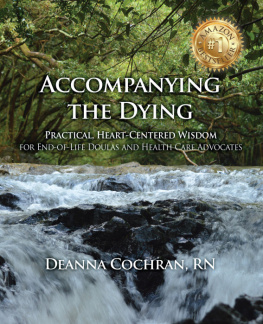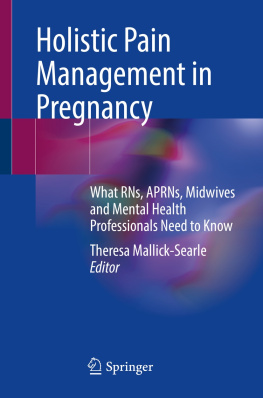
The Business of
Maternity Care
A GUIDE FOR MIDWIVES AND DOULAS
SETTING UP IN PRIVATE PRACTICE
Denise Tiran

Contents
The Purpose of this Book
Having spent over 25 years writing professionally, primarily on maternity complementary therapies, but also on midwifery in general, this book is a move away from my usual subject area and has been an interesting one to write. In many respects it has been easier, not least because, unlike my last book, Complementary Therapies in Maternity Care: An Evidence-Based Approach (2018), which had 70 pages of research references, this one has only a few! Conversely, it has been more difficult putting into words the lessons I have learned since going into business for myself and trying to decide what information you may need to help you along your own journey to starting your business.
With this book I hope to provide you with some practical tips to help you decide if you wish to set up your own practice and to avoid some of the mistakes that I, and many others before me, have made. I hope to give you sufficient information to understand the steps you need to take, the important professional, legal and financial issues you should address, and the ways in which you can market your business to build a successful future.
You will, of course, have your own ideas about what you want to do, and it is important to trust your instincts, but also to know when and how to ask for help. Setting up a business means you are entering a whole new world and having to learn a completely new subject area and its jargon. People often talk about working on the business, not working in it meaning that it is equally necessary to spend time learning about and attending to the business matters that help your practice to thrive, as well as keeping up-to-date on maternity issues and how they relate to your own profession and then doing the work of the practice on a day-to-day basis. Starting a new business venture requires blood, sweat and tears but I hope, by reading this book, you will forge ahead with your ideas with an organised approach that ensures your success. Good luck!
Introduction
My journey from midwife to businesswoman
I always wanted to be a midwife, from the age of 15, specifically a community midwife. Like many, I had experienced the usual teenage desire to become a nurse but, for some unknown reason, I focused on becoming a midwife although no one in my family knew anything about the profession. My decision might have had something to do with wanting the status of being a doctor but not achieving adequate A-level grades to study medicine. When I left school in the 1970s, the normal route to midwifery was through nursing, so my mother took me to the school careers convention to find out more. She had a momentary panic when I announced I was going to train as a nurse in the Queen Alexandras Royal Army Nursing Corps (presumably she was worried in case there was a war). However, she managed to dissuade me, and eventually I gained a place to study nursing at the prestigious St Bartholomews Hospital in the City of London.
I spent a frustrating three years studying to be a nurse, enjoying obstetrics (of course) and specialities such as the emergency department and theatre work. I hated, with a vengeance, the routines of medical and surgical ward work, and was petrified by the intensive care unit. I am sure I was never really a good nurse because my heart was not in it. Thankfully I was released from nursing and commenced midwifery training in North London almost immediately. I returned to Barts on qualifying and spent a pleasant few months working permanent night duty on the labour ward to consolidate my learning.
Unusually for the time, within a year of becoming a midwife, I was given the opportunity to take up a community-based post in Surrey, mainly practising midwifery, but with some district nursing included (unfortunately too many elderly calloused feet to dress!). I enjoyed just over a year of having my own caseload, conducting home births and becoming known within the local area as the midwife. I remember the father of one of the mothers commenting on the fact that I was not a typical district midwife because I was not 40, wearing a cap and riding a bike! I was just 24 years old, always threw my cap on the back seat of the car, and would have had difficulty completing my days work on a bike as there were sometimes ten miles between visits.
Indeed, I quickly recognised that there was not sufficient mental stimulation from the work I was doing. This was not because I disliked community work no, I loved it and still, almost 40 years later, I remain committed to community midwifery. However, working in a very rural area meant there was just not enough to do. I am sure todays midwives find that difficult to believe and perhaps wish they could say the same, given the 21st-century workload in the National Health Service (NHS) maternity services. After some deliberation, I decided to go into midwifery teaching and initially took a post as an obstetric tutor in Central London, teaching student nurses undertaking their mandatory four-week obstetrics placement. About a year later I moved to a small maternity unit in South East London, which was part of the then Greenwich and Bexley School of Midwifery. I was seconded to complete my Postgraduate Certificate in Education (PGCE) at the University of Surrey and returned to work in what had evolved into the School of Health at the University of Greenwich.
Once working in the higher education sector, numerous opportunities arise for lecturers to develop areas of interest and expertise. In the early 1980s, midwives were required to attend a one-week refresher course every five years, and tutors were allowed to attend one course that was not midwifery-specific but on a subject that could be applied to midwifery. I opted to attend a week-long course to qualify in massage. I returned to the university and started to include massage in my teaching of students and my care of women.
Following a very short break for maternity leave (a home birth), I then decided to attend what I thought was a reflexology course, but which turned out to be a specific German clinical style called reflex zone therapy, developed by a midwife, Hanne Marquardt. I was still breastfeeding my son at the time, and was amazed to experience increased lactation whilst on the course. The tutor explained that, during the previous days practical work, my colleague had slightly over-stimulated the reflex zones for the pituitary gland on my feet. A passion was born! Reflex zone therapy became and remains my principal therapy, and I find it fascinating how it applies to pregnancy, birth and postnatal care. The following year I completed an aromatherapy qualification but, whilst the tutor was a lovely therapist, she was not a good teacher, and I was largely self-taught in terms of the theory.
Back at the University of Greenwich I had been asked to develop a short introductory post-registration module on complementary therapies for qualified nurses and midwives. The general public was increasingly interested in using alternative medicine and the complementary professions were gradually formalising their pre-registration training courses and continuing education, as well as the services available, albeit almost entirely private at this stage. Whilst palliative care, particularly oncology, was the clinical field most fervently embracing complementary therapies, interest amongst pregnant women was also steadily rising. This was mainly because women wanted non-medical alternatives to deal with the many discomforts of pregnancy. Somewhat erroneously, they perceived complementary therapies as being safer than drugs because they are natural (a misconception that persists today). Suffice it to say that midwives and doctors were increasingly being asked about complementary therapies and natural remedies but were not sufficiently informed to be able to advise women appropriately. This short module eventually evolved into first, a Diploma of Higher Education and later, a full undergraduate Bachelor of Science Honours (BSc Hons) degree programme on complementary therapies, which I developed and managed for 14 years. I continued my own learning and completed a Masters degree in Health Research for which I investigated the safety of aromatherapy in pregnancy. In the complementary medicine field I studied herbal medicine, homeopathy and Bach flower remedies, learned how to use moxibustion for women with breech presentation and read voraciously on nutrition and other aspects of complementary medicine. I also completed a course in sexual counselling and, several years later, I trained in clinical hypnosis for childbirth and maternity acupuncture.
Next page



![David Caren - The Irish Dads Survival Guide to Pregnancy [& Beyond]](/uploads/posts/book/393357/thumbs/david-caren-the-irish-dad-s-survival-guide-to.jpg)





